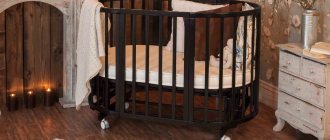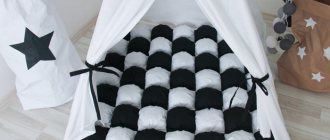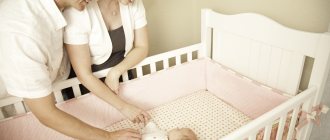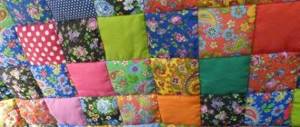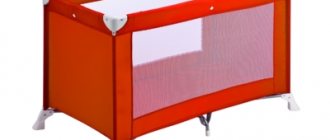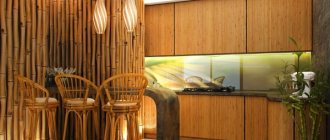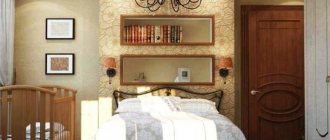What kind of blanket is there for a newborn?
Today, the market offers many baby blankets for a newborn, varying both in color and in the material from which they were made, and even in shape.
Duvets are very popular because they are absolutely environmentally friendly, incredibly light, made exclusively from natural materials, perfectly “breathe” and warm. But they also have disadvantages - they get damp very quickly and require regular drying, and can cause allergies in a child. Cotton blankets are made from cotton wool, do not cause allergies, and retain heat well. However, they are too heavy, strongly absorb unpleasant odors and moisture, and over time they form into lumps.
Wool blankets absorb moisture well, but the first two quickly erode it, remain dry for a long time, are made from natural materials, warm well, and “breathe.” There are knitted, woven and quilted.
A fur baby blanket is usually not placed in a newborn's crib. It is used to cover a child during a winter walk.
Synthetic blankets are the most affordable. They are airy, hypoallergenic, retain heat well and do not require special care. They can be easily washed both by hand and by machine.
A flannelette blanket is soft, gentle, does not cause irritation to children's skin, and is incredibly comfortable. Made from 100% cotton. Suitable for summer.
The fleece blanket is hypoallergenic, does not overheat the baby’s skin, and maintains the desired temperature. Quite thin.
A modern transformable blanket for a newborn is made according to the “2 in 1” principle; it can quickly be transformed from a regular blanket into an envelope. It will be useful not only at home, but also for walks with your baby. Can be made from various natural materials.
What requirements should be taken into account when choosing a blanket?
When choosing a baby blanket, you first need to consider the size of the crib. A model that is too large will have to be tucked in; it will bunch up and not provide the necessary heat. A small product will not cover the baby completely; arms and legs will stick out into the air and freeze. Measure the frame and take a blanket that matches the length of the bed and is 15-20 cm wider in width.
Many parents like only natural materials, and they prefer products made from wool and down. There is nothing bad to say about such blankets, but they can cause an allergy attack. Try placing your baby next to an adult blanket made of the same material and see how the baby reacts to the filling. If you don’t notice any tears, runny nose, or cough, you can cover your baby. If you notice a negative reaction, it is better to choose a model with a different filler.
There are other requirements for a baby blanket. The baby should neither freeze nor sweat. He needs to sleep comfortably, so that all bedding allows air to pass through well and does not absorb foreign odors. A baby can wet the bed several times a day, so the blanket must withstand many washes and dry quickly.
What products are offered for newborns? In stores you can find models made of wool or flannel.
Are you choosing a blanket for a baby who has just been born? The product must be suitable in size, thickness, material and color. Let's determine which blanket to choose for new parents.
An invariable attribute of a baby’s “equipment” is a blanket - soft, warm and cozy. Parents, grandparents, as well as other relatives who want to give a newborn a truly useful gift are puzzled by its purchase.
On a note! A blanket is a dense product that is used as a blanket. Initially they were made from wool or wool blend fabric. Today, the choice of materials for this product is more diverse. The characteristics of a baby blanket are small size, light weight and hypoallergenic material.
Is a blanket really necessary when caring for a baby? Only after starting to use it do moms and dads become convinced of its benefits. In a beautiful blanket, the baby can be discharged from the maternity hospital. The product is used to cover the child while sleeping or walking outside, and to cover the crib with it. Once the newborn period has passed, it can be used as a floor mat for games. A blanket is one of the useful accessories that should be in a child's room.
Requirements for children's blankets
When choosing a blanket, you need to focus on the season. So, the first 5 types of these products, discussed just above, are excellent for cold autumn and winter weather, the rest - for warm summer and spring. In addition, it is necessary to pay attention to the compliance of blankets with such requirements as: good heat conduction; ability to pass air; hygroscopicity (the product must maintain a warm temperature when moisture evaporates); ease; hygiene.
In addition, a blanket for a newborn should be easy to wash, not require special care, be incapable of deformation, and be convenient to use. It is also very important to take into account such points as the naturalness of the materials from which the blanket was made. It must be of very high quality. Otherwise, irritation will appear on the baby’s skin every now and then. It is worth purchasing 2 blankets at once - winter and summer. Even better - several at once, so that there are enough for all occasions.
Requirements for a blanket for a newborn
Newborns do not have their own immunity, so the requirements for products for them are increased. Mandatory qualities that a baby's first blanket should have are:
- 1 Air permeability. Children's bedding may only be made from “breathable” materials. Even a not very active child can wrap his head in a blanket in his sleep and suffocate if it does not allow air to pass through.
- 2 Hypoallergenic. In the first months of life, it is difficult to predict which materials may cause an allergic reaction in a baby. Therefore, his blanket must be environmentally friendly, not attract dust mites and not create favorable conditions for the development of fungi and mold.
- 3 Hygroscopicity and thermal conductivity. Unlike the body of an adult, the body of a baby is not able to adapt to the temperature of the environment. To prevent the baby from sweating in his sleep, from overheating and from freezing, his blanket should absorb skin fumes as best as possible and remove them outside, while remaining dry.
- 4 Softness and light weight. Hard, dense and heavy materials can injure delicate baby skin. A blanket for a newborn should be pleasant to the touch and not put pressure on the baby with its weight.
- 5 Easy to care for. Hygienic requirements for products for children are very strict. Caring for a blanket for a baby is greatly facilitated by machine washing, so it is advisable to choose products for which it is approved.
Blanket for newborn | select the necessary properties
- Temperature regime
. Blankets for different temperature conditions can be made from almost any filler. Depending on the thickness, these can be either synthetic fibers or natural ones. As a rule, wool or synthetic fibers are used to produce warm blankets. And in terms of its thermal insulation qualities, modern synthetics are no longer inferior to wool. To produce lightweight summer blankets, cotton and again synthetics can be used.- Hypoallergenic.
Synthetic fibers are unsuitable for use as food by bed mites and other living creatures, which is why they have significantly higher hypoallergenic qualities. Therefore, you should not dismiss synthetics when choosing a blanket for a newborn. Manufacturers report high hypoallergenic qualities of cotton, bamboo and camel wool, but I would still advise when choosing a blanket to remember that: natural fibers are an ideal habitat for bed mites, which are the cause of allergies; - In the production of any type of filler, an unscrupulous manufacturer may use toxic substances. Most often, such substances are used to soften fibers or as dyes. It is for this reason that you should give preference to proven brands.
. Depending on the manufacturing technology, blankets made from the same fibers can feel very different to the touch. Some synthetic fibers are not as pleasant to the touch, but a duvet cover solves this problem. At the same time, blankets made from high-quality synthetic fibers are much lighter and softer. Leaders in light weight blankets with synthetic fillers. They are light as a feather and even newborn babies are very comfortable under them!
When it comes to babies (including newborns), the question of washing often arises. And in this matter, synthetic fibers are again in the lead - they can be washed in a machine and there is no fear that the blanket will shrink or the filling will bunch up. Of course, we are talking about high-quality synthetic fibers.
. A very important quality for many is the speed of drying of the blanket! Synthetic fillers are also leaders in this position! Our favorite holophane blanket dries in just 3 hours in a ventilated room at room temperature 22 degrees, in the sun at 30 degrees - about 1.5 hours. At the same time, a classic flannelette blanket needs about 10 hours to dry completely at room temperature 22 degrees. If we are talking about drying a flannel blanket in winter, then the time increases to a day.
are classic wool and cotton. Cotton is ideal for warm climates. Wool is used when it is necessary to retain heat.
I see no point in diluting the excellent characteristics of synthetic fibers with natural ones. As an exception, I’ll probably point out wool mixture. I just ask you to take into account that half-wool should be chosen in cases where you see a neat texture of the fabric. For example, you can find excellent options for wool blend blankets. As for quilts filled with wool blends, I would advise you to avoid them, as there is too much of a chance that they are trying to sell you a pig in a poke.
It is believed that synthetics do not allow the body to “breathe,” but is this really so? It turns out that everything is almost the opposite! With natural fibers everything works fine until the moment when sweat appears. At the moment of sweating, natural fibers, due to their hygroscopicity, absorb moisture and then stop letting air through. As for synthetics, there are “breathable” and “non-breathable” synthetics. The use of non-breathable synthetics for blankets is unacceptable. The breathable synthetic blanket is ideal even for newborns. When covering with woolen blankets, you should be especially careful to avoid overheating, as the blanket may sweat and lose its breathability.
Everything is simple here, the larger the budget, the better the quality of the fiber. The concept of quality includes thermal insulation, breathability, softness, hygroscopicity, and resistance to washing. I will list the most popular ones in ascending order of quality: padding polyester, holofiber (analogues slightly different in the processing technology of holofane), Thinsulate, Isosoft. The cheapest and least quality padding polyester on this list. I guess I didn’t buy it for a newborn baby, but all the others are quite appropriate and modern.
